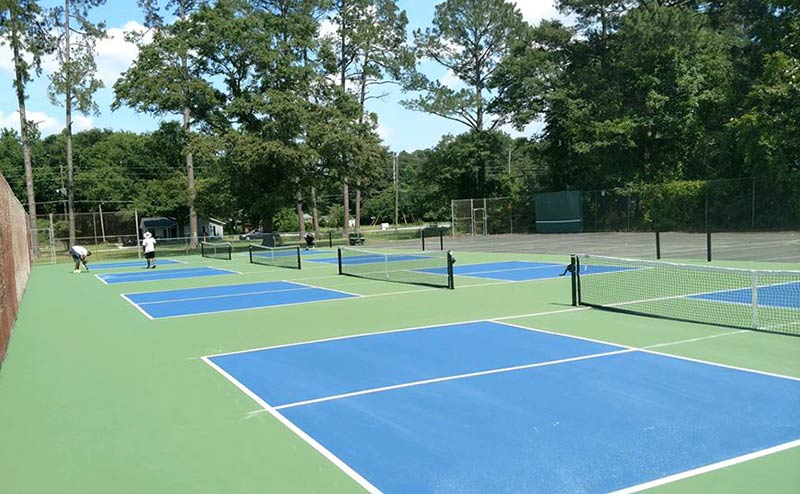Pickleball Court Construction-- Professional Installment for Your Desire Court
Pickleball Court Construction-- Professional Installment for Your Desire Court
Blog Article
Sustainable Practices in Pickleball Court Building And Construction You Ought To Know
As the popularity of pickleball continues to increase, so also does the need for sustainable methods in court building and construction. The effect of these practices expands far past the court itself.
Choosing Eco-Friendly Products
Selecting green materials is a crucial step in the building of lasting pickleball courts. The choice of sustainable products not only minimizes environmental influence but also improves the durability and performance of the court. Trick materials include reused rubber for the surface area, which offers excellent resilience and shock absorption while drawing away waste from garbage dumps.
Furthermore, utilizing in your area sourced materials minimizes transportation discharges and supports local economic climates. Pickleball court construction. As an example, making use of native woods for fence and seats can give a sustainable visual while making sure durability against the components.
Including absorptive products for court foundations can further add to sustainability by enabling natural water drainage and reducing overflow. These choices not just safeguard regional ecosystems however also advertise much healthier play atmospheres.
Effective Water Drainage Solutions
While the choice of eco-friendly products is vital, executing efficient drainage remedies is equally important for preserving lasting pickleball courts. Correct drainage not only secures the court surface from water damages yet additionally decreases erosion and drainage, advertising environmental honesty.
Effective drainage systems can include absorptive paving, which allows water to penetrate the ground rather than merging externally. This minimizes the likelihood of standing water, which can lead to mold and other maintenance issues. Furthermore, including purposefully positioned drain networks and swales can direct excess water away from the court area, making sure a dry playing surface and protecting against soil erosion.
Utilizing native plants in the landscape design around the courts can even more improve drain by soaking up excess water and minimizing runoff. These plants need less irrigation and promote biodiversity, aligning with sustainable techniques.
Moreover, it is critical to routinely preserve the drain system to ensure its long-term performance. This consists of cleaning debris and monitoring for blockages. By prioritizing reliable water drainage options, pickleball court manufacturers can significantly contribute to the sustainability and long life of the facility, eventually benefiting both gamers and the atmosphere.
Energy-Efficient Lights Options
As the demand for pickleball continues to grow, integrating energy-efficient lights options right into court style has become increasingly important for sustainability. Traditional illumination systems often consume too much energy, contributing to higher functional expenses and environmental effect. Embracing contemporary, energy-efficient technologies is crucial for both new buildings and restorations.
LED (Light Emitting Diode) illumination stands apart as a premier choice as a result of its durability and energy financial savings (Pickleball court construction). Compared to conventional lights, LEDs utilize approximately 75% less power and can last up to 25 times much longer, considerably decreasing upkeep costs. Additionally, the directional nature of review LED lighting lessens light pollution, making certain that illumination is concentrated on the court instead than surrounding locations.

Lasting Surface Area Alternatives
Checking out lasting surface options for pickleball courts has actually acquired grip amongst home builders and gamers alike. The emphasis on green products not just aligns with the growing environmental understanding yet also enhances the performance and durability of the courts.
One prominent option is using recycled rubber, which can be sourced from made use of tires. This product provides outstanding shock absorption, lowering the risk of injuries for gamers while promoting sustainability. Furthermore, modular tiles made from recycled plastics provide one more sensible alternative. These floor tiles are easy to mount and change, and their convenience allows for different court arrangements.
Natural yard courts are additionally becoming a lasting selection, promoting biodiversity and minimizing the heat island impact. They need regular upkeep and water, which may not line up with all sustainability objectives.

Water Conservation Methods

One more effective method includes the setup of rainwater harvesting systems. These systems save and accumulate rain for usage in preserving court surfaces go to this web-site and landscaping. This technique not only preserves safe and clean water however also minimizes dependence on local resources.
Furthermore, utilizing drought-resistant landscaping around the courts is essential. Indigenous plants require less water and are much better adapted to neighborhood climate conditions, therefore lowering overall water intake. Additionally, making use of efficient irrigation systems, such as drip irrigation, ensures that water is provided straight to plant origins, decreasing dissipation and waste.
Conclusion
Incorporating sustainable practices in pickleball court construction considerably adds to ecological preservation and source efficiency. By focusing on these practices, the building and construction of pickleball courts can straighten with broader ecological goals while advertising longevity and performance within areas.
As the popularity of pickleball proceeds to climb, so also does the demand for lasting methods in court building.Selecting green materials is an important action in the building and construction of lasting pickleball courts. By focusing on energy-efficient lighting choices, pickleball court manufacturers can contribute to a more sustainable future while meeting the needs of players and stakeholders alike.Including lasting surface area options not only enhances the performance of pickleball courts yet also leads the means for implementing effective water preservation methods.Integrating lasting techniques in pickleball court construction significantly adds to environmental preservation and source effectiveness.
Report this page